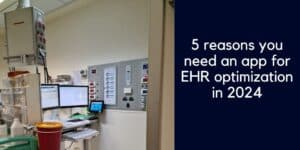What’s inside:
This article looks at the struggles nurses face in documenting surgical data.
We discover the four biggest problems nurses experience when charting usage during surgery.
Are current data capture options helping or hindering busy perioperative nurses?
We regularly hit the road and take time to network with perioperative nurses, asking them about their experiences documenting utilization in surgery.
We learn about the different systems and processes in place, as well as the various tools or manual workflows currently being used.
All every organization does things differently, it’s clear that many nurses face daily frustration when trying to record the full list of medical devices and implants used in surgery.
The four biggest problems nurses face when recording surgical utilization
We asked nurses attending our AORN roadshows for their biggest frustrations when trying to document usage at the point of care, so let’s look at the top four frustrations in reverse order.
Surgical charge capture
Nurses often struggle with charge capture when recording surgical data. Some nurses commented that the database being used did not adequately synch with the charge capture system.
For many hospitals the technology they use works in silos and nurses crave for joined up thinking and interoperable systems.
Clunky, siloed systems mean that all too often senor OR staff and the RCM team need to step in to review and update the medical chart in order to ensure accurate billing and optimum case revenue.
Documentation Errors
When manual inputting is involved, nurses acknowledge that human errors are common.
When creating a digital record of usage during surgery, entering the wrong number will either result in a system error, or the wrong item being recorded.
Even where scanning tools are in place, nurses often end up resorting to manual data entry due to barcode readability issues or system errors.
Despite the availability of automation tools, manual inputting is still a common practice in many surgery and procedure rooms.
Inputting strings of small figures from product packaging into the system during surgery is known to be error prone, so it’s a shame that it’s still so prevalent across the US healthcare system.
Documentation Time
When we speak to nurses, one of the most common complaints we hear about point of care documentation, is the time and effort it takes.
Particular bugbears are where the healthcare provider has paper records or manual imputing – nurses recognize that this distracts them from focusing on the patient:
“Whether making handwritten notes, or keying in data onto the computer,
documenting takes too much time away from patient care.”
Another common comment is the number of items that aren’t on the Pick List and prove problematic to document:
“There are time constraints documenting items not covered on the pick ticket during surgical procedures.”
Sometimes the system may flag up that full data has not been captured. This will require finding another barcode on the packaging that contains the correct information – which can be difficult when items regularly contain multiple barcode sticks. More likely they will end up keying the missing data in.
Nurses regularly feed back that recording usage in surgery is far from straight forward and diverts their time away from patient care.
Time for the drum roll.
Let’s find out the most common frustration faced by nurses documenting medical devices and implants at the point of care.
Items not in the system
By far the biggest problem expressed by nurses is the fact that hospital systems do not contain the full list of items that are regularly used in surgery.
When this happens there is an exception error after the item is entered or scanned in.
Nurses report that many items are non-catalogued and require ‘one-time entries’. Many nurses highlighted the increase in substitute products over the past few years and point out that these are less likely to be in the system.
The additional workload caused by unlisted items is a burden that many nurses simply don’t have time for, and this issue can result in mis-recorded items or undocumented implants.
“If the item isn’t found in the database, many will not search to find the correct item,
so, they may not be charging for the exact item used.”
Another common point made by nurses is the impact of item number alterations – this is when a stock item code changes, so that the details stored on file are no longer up to date. This means that when the item is scanned or manually entered into the system, the new code is not recognized.
Maintaining the Item Master is a never-ending task for healthcare providers, but as this file acts as the ‘source of truth’ for several systems, errors, omissions and out-date information will cause problems and delays for users and slow down workflows.
Nurses report that far too many items cannot be easily recorded during surgery and that this distracts them from patient care and can result in post-surgery ‘catch up’ documentation. When utilization is not recorded during surgery this raises the risk of non-documentation.
So, there you have it. The four biggest frustrations that nurses face when documenting medical devices and implants in procedures and surgery.
Here’s how the breakdown looks in chart format:

Don’t miss the next blog which is all about solving these issues.
Find out what these nurses had to say about IDENTI’s new approach to surgical data capture.
Can changing the point of use data capture tool put an end to their everyday frustrations?
Check out our blog on nurse feedback on Snap & Go!
Contact us if you are seeking a better way to document medical devices and implants in surgery.








